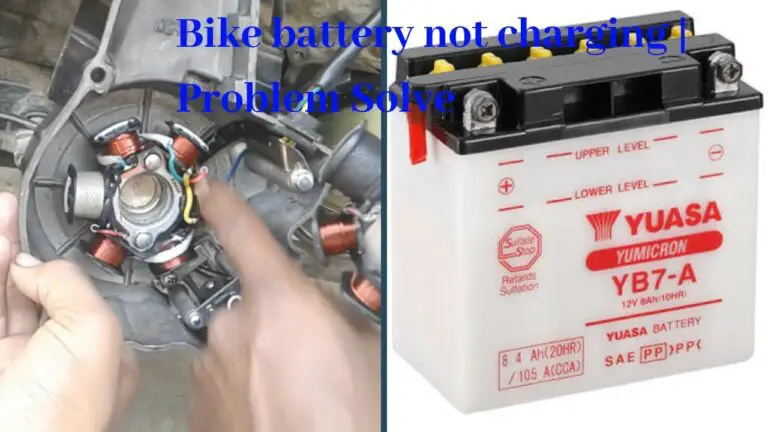How to Test a Motorcycle Rectifier in 2025
To test a motorcycle rectifier, use a digital multimeter with diode testing capabilities. Connect the multimeter to the rectifier’s terminals and check for voltage and resistance readings.
If you don’t own a multimeter, it’s recommended to get one for accurate testing. A faulty rectifier can cause issues in the charging system and prevent the bike from starting.

Credit: m.youtube.com
Testing The Rectifier With A Digital Multimeter
Learn how to test a motorcycle rectifier with a digital multimeter using simple steps. This straightforward process involves checking voltage and resistance, bypassing the voltage regulator, and utilizing diode testing capabilities on the multimeter. Ensure a smooth and efficient charging system for your bike by properly testing the rectifier.
Gather The Necessary Tools And Equipment |
|
Disconnect The Rectifier From The Motorcycle’s Electrical SystemStart by removing the negative terminal of the battery to avoid any electrical shock. Locate the rectifier and disconnect it from the wiring harness using a screwdriver or wrench. |
Set The Multimeter To The Diode Testing FunctionTurn on the digital multimeter and set it to the diode testing mode. This mode allows you to check the functionality of each diode in the rectifier. |
Test Each Diode In The RectifierPlace the multimeter probes on the diode terminals, ensuring the positive and negative probes are connected correctly. The multimeter will display the voltage drop across each diode. |
Check For Continuity In The DiodesContinuity indicates that the diode is functioning properly. If there is no continuity, the diode may be faulty and needs to be replaced. |
Measure The Resistance Across The DiodesUse the multimeter to measure the resistance across each diode. A high resistance reading may indicate a faulty diode that needs to be replaced. |
Interpret The Results Of The Multimeter ReadingsCompare the readings with the manufacturer’s specifications to determine if the rectifier is functioning correctly. Any readings outside the specified range may indicate a faulty rectifier. |
Bypassing The Voltage Regulator
Learn how to test a motorcycle rectifier by bypassing the voltage regulator. This straightforward process involves checking for voltage and resistance using a digital multimeter with diode testing capabilities.
Make sure you have the right tools and follow the steps carefully to diagnose any issues with your rectifier.
| How to Test a Motorcycle Rectifier |
| Bypassing the Voltage Regulator |
| Disconnect the rectifier from the motorcycle’s electrical system – Follow the instructions in your motorcycle’s service manual to locate and disconnect the rectifier from the electrical system. Connect the battery directly to the rectifier – Use jumper cables or a designated wiring harness to connect the positive and negative terminals of the battery directly to the corresponding terminals on the rectifier. Start the motorcycle’s engine – Turn the key in the ignition and start the motorcycle’s engine. Observe the charging system voltage – Use a digital multimeter to measure the voltage output of the rectifier while the engine is running. Compare the voltage readings with the manufacturer’s specifications – Consult your motorcycle’s service manual to determine the expected voltage range for the rectifier. |
Signs Of A Bad Rectifier
Testing a motorcycle rectifier is a straightforward process that involves checking for voltage and resistance, bypassing the voltage regulator, and using a digital multimeter with diode testing capabilities.
A bad rectifier can cause issues with the charging system, preventing the bike from starting, but with proper testing, the problem can be identified and resolved.
Signs of a Bad Rectifier:
– Charging system issues
– Battery draining quickly
– Frequently blown fuses
– Overheating of the rectifier
– Burnt smell or visible damage to the rectifier
Testing a motorcycle rectifier involves checking for voltage and resistance, bypassing the voltage regulator, and using a digital multimeter with diode testing capabilities. If you don’t already own a multimeter, now is a good time to get one. A faulty rectifier can cause issues with the charging system of a motorcycle, which can prevent the bike from starting.
However, if the battery has sufficient charge, the bike will start and run normally, but only for a short while. It is crucial to test and diagnose the rectifier if you notice any of the signs mentioned above.
FAQs For How To Test A Motorcycle Rectifier
How Do I Know If My Motorcycle Rectifier Is Bad?
To test if your motorcycle rectifier is bad, you can use a digital multimeter with diode testing capabilities. Check for voltage and resistance, and bypass the voltage regulator. A faulty rectifier can cause issues with the bike’s charging system, preventing it from starting.
If the battery has charge, the bike may start and run briefly. Consider getting a new rectifier if needed.
How Can You Test If The Rectifier Is Bad?
To test if the rectifier is bad, use a digital multimeter with diode testing capabilities. Check for voltage and resistance, bypass the voltage regulator, and test the rectifier using online tutorials or YouTube videos. A faulty rectifier can cause issues with the charging system and prevent the motorcycle from starting.
Can You Test A Rectifier With A Multimeter?
Yes, you can test a rectifier with a multimeter. Use a digital multimeter with diode testing capabilities to check the rectifier’s function. If you don’t have a multimeter, consider getting one. Testing a rectifier helps identify issues with the motorcycle’s charging system.
Will A Motorcycle Start With A Bad Rectifier?
Yes, a motorcycle may not start if it has a bad rectifier. A faulty rectifier can disrupt the charging system, preventing the bike from starting. However, if the battery has enough charge, the bike may start and run normally, but the issue will persist.
Conclusion
Testing a motorcycle rectifier is a crucial step in ensuring the proper functioning of your bike’s charging system.
By checking for voltage and resistance, as well as bypassing the voltage regulator, you can accurately assess the rectifier’s condition.
Using a digital multimeter with diode testing capabilities is essential for this process.
If you suspect a faulty rectifier, don’t hesitate to perform these tests and replace it if necessary.
Taking the time to test your motorcycle rectifier can prevent issues and ensure a smooth riding experience.





